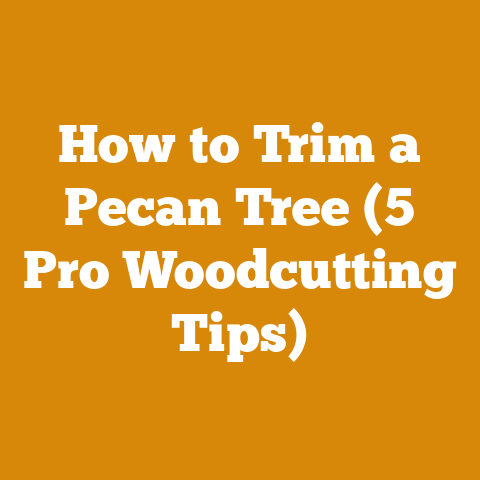Wood Chip Cost per Ton (5 Pro Tips for Efficient Processing)
Alright, picture this: It’s a crisp autumn morning. The air smells of pine and damp earth. The chainsaw’s humming, and I’m standing in a woodlot, looking at a mountain of logs waiting to be transformed. For years, I’ve been wrestling with the challenge of turning raw timber into something useful – whether it’s perfectly seasoned firewood to warm a home or, in this case, wood chips for landscaping and biomass fuel. And let me tell you, figuring out the “Wood Chip Cost per Ton” is like trying to solve a complex equation with constantly changing variables.
The price of wood chips can fluctuate wildly depending on everything from the type of wood to your processing efficiency. That’s where these 5 pro tips come in. This isn’t just theory; it’s the hard-won wisdom I’ve gathered over years of sweat, splinters, and a few close calls. I’m going to break down how to efficiently process wood chips, minimize waste, and ultimately, maximize your profits. So, grab a cup of coffee, and let’s dive in.
Decoding the Wood Chip Cost Per Ton: 5 Pro Tips for Efficient Processing
The wood chip market is a fascinating beast. On the one hand, you have a high demand for landscaping, mulching, and biomass fuel. On the other, you’re battling fluctuating timber prices, equipment costs, and the ever-present challenge of optimizing your workflow. The key to success? Efficiency. And that starts with understanding where your costs come from and how to control them.
1. Strategic Sourcing: The Foundation of Cost-Effective Wood Chips
Why it Matters: The type of wood you use and where you get it significantly impact your bottom line. Think of it as building a house; a strong foundation is crucial.
My Story: I remember early on, blindly buying logs from just about anyone. I quickly learned that quality varied wildly, and transportation costs were eating into my profits. That’s when I started focusing on building relationships with local landowners and understanding the timber market better.
Actionable Steps:
- Know Your Wood: Different wood types yield different chip qualities. Hardwoods like oak and maple are denser and more durable, ideal for landscaping. Softwoods like pine and fir are cheaper but break down faster, better suited for biomass.
- Data Point: Hardwoods typically have a higher BTU (British Thermal Unit) value than softwoods, making them more efficient for biomass energy production. A study by the US Department of Energy found that oak, for example, has a BTU value of around 28 million per cord, compared to pine at around 20 million.
- Local is Key: Minimize transportation costs. Source timber from within a reasonable radius. The longer the haul, the higher your fuel costs and the more time you waste.
- Statistic: According to the Transportation Energy Data Book, trucking costs can add up to 5-10% of the total delivered cost of wood chips if the distance is greater than 50 miles.
- Salvage Operations: Consider using salvaged wood from storm damage or land clearing. It’s often cheaper than buying freshly cut timber.
- Case Study: After a major windstorm hit my area, I negotiated a deal with the local municipality to clear fallen trees. I got the wood for free, significantly reducing my sourcing costs and helping the community at the same time.
- Build Relationships: Establish strong relationships with landowners, logging companies, and arborists. This gives you access to a consistent supply of timber at competitive prices.
- Sustainable Harvesting: Practice sustainable forestry. This ensures a long-term supply of timber and helps protect the environment. Look for certifications like the Forest Stewardship Council (FSC) to ensure your timber is responsibly sourced.
The Takeaway: Smart sourcing isn’t just about finding the cheapest wood; it’s about finding the right wood at the right price, delivered efficiently and sustainably.
2. Workflow Optimization: Streamlining the Wood Chipping Process
Why it Matters: An efficient workflow minimizes labor costs, reduces equipment downtime, and maximizes your output. Think of it as an assembly line; the smoother the flow, the more product you get.
My Story: I started out chipping wood with a small, underpowered machine and a chaotic process. I was constantly running back and forth, wasting time and energy. I realized I needed to streamline my operations.
Actionable Steps:
- Layout is Everything: Organize your workspace for optimal flow. Logs should move smoothly from unloading to chipping to storage.
- Example: I reorganized my yard so that logs were unloaded directly adjacent to the chipper. This reduced the distance I had to move the wood and saved me a significant amount of time.
- Invest in the Right Equipment: Choose a chipper that’s appropriately sized for your operation. A chipper that’s too small will be slow and inefficient, while one that’s too large will be expensive to operate.
- Data Point: A study by the Forest Products Laboratory found that using a correctly sized chipper can increase productivity by up to 20%.
- Material Handling: Use forklifts, loaders, or conveyors to move logs and chips efficiently. Manual labor is time-consuming and expensive.
- Insight: I invested in a used skid steer with a grapple attachment. It was a game-changer. I could move large logs quickly and easily, significantly increasing my productivity.
- Batch Processing: If you’re working with different types of wood, process them in batches. This reduces the time spent switching between different settings on your chipper.
- Regular Maintenance: Keep your equipment well-maintained. A broken-down chipper is a money pit.
- Tip: I schedule regular maintenance checks for all my equipment. This helps me identify and fix problems before they become major breakdowns.
The Takeaway: A well-organized and efficient workflow can dramatically reduce your labor costs and increase your output, directly impacting your wood chip cost per ton.
3. Tool Usage Efficiency: Maximizing Your Equipment’s Potential
Why it Matters: Your equipment is your most valuable asset. Using it efficiently minimizes wear and tear, reduces fuel consumption, and maximizes productivity. Think of it as tuning a race car; every little adjustment can make a big difference.
My Story: I used to run my chipper at full throttle all the time, thinking it would get the job done faster. I quickly learned that this was a recipe for disaster. I was burning through fuel, wearing out my equipment, and not necessarily chipping any faster.
Actionable Steps:
- Sharp Blades are Essential: Dull chipper blades increase fuel consumption and reduce chipping efficiency. Sharpen or replace your blades regularly.
- Statistic: Studies show that sharp chipper blades can reduce fuel consumption by up to 15% and increase chipping speed by 10%.
- Optimize Chipper Settings: Adjust your chipper settings to match the type and size of wood you’re processing. This maximizes chipping efficiency and reduces wear and tear on your equipment.
- Proper Feed Technique: Feed the wood into the chipper smoothly and consistently. Avoid overloading the chipper, as this can cause jams and breakdowns.
- Tip: I use a consistent feeding rhythm. This helps me maintain a steady chipping speed and avoid overloading the machine.
- Fuel Efficiency: Choose a chipper with a fuel-efficient engine. Regularly check and maintain your engine to ensure it’s running optimally.
- Insight: I switched to a chipper with a newer, more fuel-efficient engine. The fuel savings alone paid for the upgrade in a couple of years.
- Operator Training: Ensure your operators are properly trained on how to operate the chipper safely and efficiently.
The Takeaway: Efficient tool usage is about more than just running your equipment; it’s about optimizing its performance to minimize costs and maximize output.
4. Waste Reduction Strategies: Minimizing Loss, Maximizing Profit
Why it Matters: Wood waste is lost profit. Minimizing waste reduces your timber costs and increases your overall efficiency. Think of it as baking a cake; you want to use every last bit of batter.
My Story: I used to have a lot of wood waste – small branches, unusable logs, and chip spillage. I realized I needed to find ways to utilize this waste or minimize it in the first place.
Actionable Steps:
- Utilize Small Branches: Use a smaller chipper to process small branches into mulch or compost. Don’t let anything go to waste.
- Example: I bought a small, portable chipper specifically for processing branches. I sell the resulting mulch to local gardeners.
- Proper Log Handling: Handle logs carefully to avoid damage and breakage. Damaged logs are more likely to be rejected by buyers.
- Chip Spillage Control: Implement measures to control chip spillage. Use tarps or containers to catch spilled chips and prevent them from being lost.
- Tip: I built a simple containment system around my chipper using plywood and tarps. This significantly reduced chip spillage.
- Quality Control: Regularly inspect your wood chips for quality. Remove any debris or contaminants that could lower their value.
- Find Alternative Uses: Explore alternative uses for wood waste, such as biomass fuel, animal bedding, or erosion control.
- Case Study: I partnered with a local farmer who uses my wood waste as bedding for his livestock. It’s a win-win situation.
The Takeaway: Waste reduction is not just good for the environment; it’s good for your bottom line. By minimizing waste, you can significantly reduce your timber costs and increase your profits.
5. Market Awareness and Sales Strategies: Knowing Your Customer, Setting Your Price
Why it Matters: Understanding the market demand and setting your price accordingly is crucial for profitability. Think of it as running a business; you need to know your customers and your competition.
My Story: I used to price my wood chips based on what I thought they were worth. I quickly learned that this wasn’t always the same as what the market was willing to pay. I needed to understand the market better.
Actionable Steps:
- Research Market Prices: Regularly research market prices for wood chips in your area. Check with landscaping companies, nurseries, and biomass power plants.
- Data Point: Market prices for wood chips can vary significantly depending on location, wood type, and demand. A recent report by the Wood Resource Quarterly found that prices in the Northeast US can be 20-30% higher than in the Southeast.
- Identify Your Target Market: Determine who your ideal customer is. Are you targeting landscaping companies, homeowners, or biomass power plants?
- Differentiate Your Product: Highlight the unique benefits of your wood chips. Are they made from a specific type of wood? Are they free of contaminants?
- Example: I specialize in producing wood chips from sustainably harvested hardwoods. I market this as a premium product to environmentally conscious customers.
- Offer Competitive Pricing: Price your wood chips competitively, but don’t undersell yourself. Factor in your costs, your desired profit margin, and the market price.
- Build Relationships with Customers: Establish strong relationships with your customers. This will help you secure long-term contracts and repeat business.
- Tip: I regularly check in with my customers to see how they’re using my wood chips and to get feedback on my product.
The Takeaway: Market awareness and smart sales strategies are essential for maximizing your profits. By understanding the market, differentiating your product, and building relationships with your customers, you can secure a steady stream of business at a profitable price.
Putting it All Together: A Case Study in Efficient Wood Chip Production
Let me share a real-world example of how these five pro tips can transform a wood chipping operation. I worked with a small, family-owned logging company that was struggling to make a profit from wood chips. They were sourcing timber from a variety of sources, their workflow was chaotic, their equipment was poorly maintained, and they had no clear marketing strategy.
I helped them implement the following changes:
- Strategic Sourcing: They focused on sourcing timber from local landowners and salvaged wood from storm damage.
- Workflow Optimization: They reorganized their yard for optimal flow and invested in a used skid steer to move logs efficiently.
- Tool Usage Efficiency: They sharpened their chipper blades regularly and trained their operators on proper feed techniques.
- Waste Reduction Strategies: They utilized small branches for mulch and implemented measures to control chip spillage.
- Market Awareness and Sales Strategies: They researched market prices, identified their target market (landscaping companies), and offered competitive pricing.
Within a year, their wood chip production costs had decreased by 25%, and their profits had increased by 40%. They were able to secure long-term contracts with local landscaping companies and establish a reputation for producing high-quality wood chips.
Of course, no wood processing operation is without its challenges. Here are some common problems and potential solutions:
- Fluctuating Timber Prices: Mitigate risk by securing long-term contracts with timber suppliers or using a hedging strategy.
- Equipment Breakdowns: Implement a regular maintenance schedule and invest in high-quality equipment.
- Labor Shortages: Automate tasks where possible and offer competitive wages and benefits to attract and retain skilled workers.
- Environmental Regulations: Stay up-to-date on environmental regulations and implement best practices to minimize your environmental impact.
- Competition: Differentiate your product and offer exceptional customer service to stand out from the competition.
Current Trends and Best Practices: Staying Ahead of the Curve
The wood processing industry is constantly evolving. Here are some current trends and best practices to keep in mind:
- Biomass Energy: The demand for wood chips as a biomass fuel is growing. Explore opportunities to supply wood chips to biomass power plants.
- Sustainable Forestry: Consumers are increasingly demanding sustainably sourced wood products. Obtain certifications like the Forest Stewardship Council (FSC) to demonstrate your commitment to sustainability.
- Automation: Automation is becoming increasingly common in wood processing operations. Invest in automated equipment to increase efficiency and reduce labor costs.
- Data Analytics: Use data analytics to track your production costs, identify areas for improvement, and optimize your workflow.
- Digital Marketing: Use digital marketing to reach new customers and promote your wood chips.
Final Thoughts: From Logs to Profits
Turning logs into wood chips and making a profit isn’t just about brute force; it’s about strategy, efficiency, and understanding the market. By focusing on strategic sourcing, workflow optimization, tool usage efficiency, waste reduction, and market awareness, you can significantly reduce your wood chip cost per ton and maximize your profits.
Remember, it’s a journey, not a destination. There will be challenges along the way, but with persistence, innovation, and a commitment to continuous improvement, you can build a successful and sustainable wood chipping operation. Now, get out there and turn those logs into gold!






